Discover 35 hidden attractions, cool sights, and unusual things to do in Ottawa (Canada). Don't miss out on these must-see attractions: Rideau Canal, Parliament Hill, and Canada Science and Technology Museum. Also, be sure to include Hog's Back Falls in your itinerary.
Below, you can find the list of the most amazing places you should visit in Ottawa (Ontario).
Table of Contents
Rideau Canal

Canal in Ontario, Canada. The Rideau Canal, also known unofficially as the Rideau Waterway, connects Canada's capital city of Ottawa, Ontario, to Lake Ontario and the Saint Lawrence River at Kingston. It is 202 kilometres long. The name Rideau, French for "curtain", is derived from the curtain-like appearance of the Rideau River's twin waterfalls where they join the Ottawa River. The canal system uses sections of two rivers, the Rideau and the Cataraqui, as well as several lakes. Parks Canada operates the Rideau Canal.
The canal was opened in 1832 as a precaution in case of war with the United States. It remains in use today primarily for pleasure boating, with most of its original structures intact. The locks on the system open for navigation in mid-May and close in mid-October. It is the oldest continuously operated canal system in North America. In 2007 it was registered as a UNESCO World Heritage Site.[1]
Address: Colonel By Dr, Ottawa
Parliament Hill
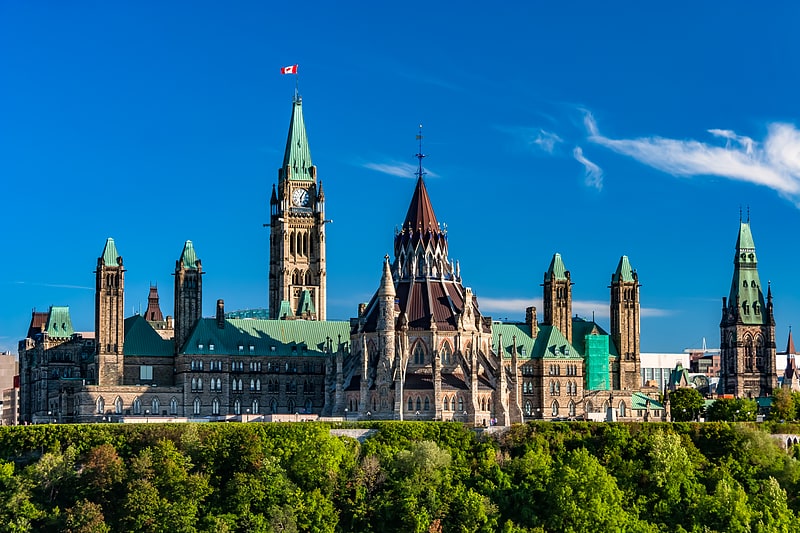
Neo-Gothic home of Canada's legislature. Parliament Hill, colloquially known as The Hill, is an area of Crown land on the southern banks of the Ottawa River in downtown Ottawa, Ontario, Canada. Its Gothic revival suite of buildings, and their architectural elements of national symbolic importance, is the home of the Parliament of Canada. Parliament Hill attracts approximately three million visitors each year. Law enforcement on Parliament Hill and in the parliamentary precinct is the responsibility of the Parliamentary Protective Service.
Originally the site of a military base in the 18th and early 19th centuries, development of the area into a governmental precinct began in 1859, after Queen Victoria chose Ottawa as the capital of the Province of Canada. Following several extensions to the parliament and departmental buildings and a fire in 1916 that destroyed the Centre Block, Parliament Hill took on its present form with the completion of the Peace Tower in 1927. Since 2002, an extensive $3 billion renovation and rehabilitation project has been underway throughout all the precinct's buildings; work is not expected to be complete until after 2028.[2]
Address: Wellington St, K1A 0A9 Ottawa
Canada Science and Technology Museum

Museum devoted to Canadian innovation. The Canada Science and Technology Museum is a national museum of science and technology in Ottawa, Ontario, Canada. The museum has a mandate to preserve and promote the country's scientific and technological heritage. The museum is housed in a 13,458 square metres building. The museum is operated by Ingenium, a Crown corporation that also operates two other national museums of Canada.
The museum originated as the science and technology branch of the defunct National Museum of Canada. The branch opened its own building in 1967, and subsequently became its own institution in 1968, named the National Museum of Science and Technology. The museum adopted its current name in 2000. The museum's building underwent significant renovations from 2014 to 2017, which saw most of the original structure demolished and replaced.
The museum's collection contains over 20,000 artifact lots with 60,000 individual objects, some of which are on display in the museum's exhibitions. The museum also hosts and orgnaizes a number of temporary and travelling exhibitions.[3]
Address: 1867 St Laurent Blvd, K1G 5A3 Ottawa
Hog's Back Falls

Waterfall in Ontario, Canada. The Hog's Back Falls, officially known as the Prince of Wales Falls, but rarely referred to by this name, are a series of artificial waterfalls on the Rideau River in Ottawa, Ontario, Canada. The falls are located just north of Mooney's Bay and the point where the Rideau Canal splits from the Rideau River.
Prior to the construction of the Rideau Canal, these were a gentle set of rapids originally known as Three Rock Rapids. The name Hog's Back came into use shortly before canal construction. Civil Engineer John MacTaggart, in 1827, described them as "a noted ridge of rocks, called the Hog’s Back, from the circumstances of raftsmen with their wares sticking on it in coming down the stream." These rapids were about 600 metres (2 000 feet) in length with a drop of about 1.8 metres (6 feet). They were navigable by canoe; no portage was required.
As part of his concept for a slackwater navigation system, Lt. Colonel John By's design for the Rideau Canal called for a large dam to be raised in this location. It would divert water from the Rideau River into the artificially-created section of the canal leading to the Ottawa locks. It would also flood the Three Island Rapids located upstream (the head of present-day Mooney's Bay marks the foot of these rapids).
The building of this dam provided one of the greatest construction challenges (it collapsed 3 times during construction) of the Rideau Canal, but when completed in 1831, it flooded the Rideau River at that point by 12.5 metres (41 feet). To accommodate the natural flow of the Rideau River and to prevent damage from spring flooding, a large wastewater weir was constructed. The water from this flows through a channel that was excavated in the eastern bank of the Rideau River. This created the Hog's Back Falls that we see today.
The head of the original rapids is now buried beneath the canal dam, but the lower section of the rapids can still be seen today.
This location marks where the route of the Rideau Canal leaves the Rideau River and enters a manmade canal leading to the Ottawa locks. A series of locks lowers boats from this location to the Ottawa River.[4]
Address: Hog's Back Road, K1A 0A1 Ottawa
Britannia Yacht Club
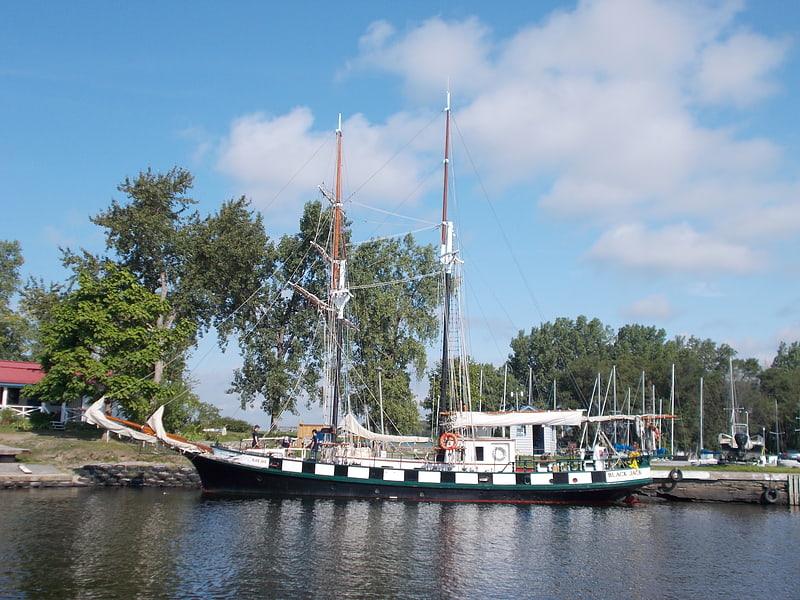
Yacht club in Ottawa, Ontario. The Britannia Yacht Club is a private social club, yacht club and tennis club based in Britannia, Ottawa, Ontario, Canada. It was founded in 1887 by a group of cottagers.
BYC is located on an extension of land at the eastern end of Lac Deschênes near the Deschênes Rapids on the Ottawa River. A land block owned by the National Capital Commission on the south side of the harbour is leased to the BYC. The area immediately south of the property is occupied by residences of Britannia Bay. The harbor was built from an abandoned power canal, which lay beside the club property. This harbor has been expanded twice since its original development. The harbor water level is controlled by a system of stop logs at its entrance.
BYC is a member of the Ontario Sailing Association, Canadian Power and Sail Squadrons, and the Canadian Yachting Association. Its officers include a Commodore, vice-commodore, rear-commodore, secretary and treasurer.[5]
National Gallery of Canada
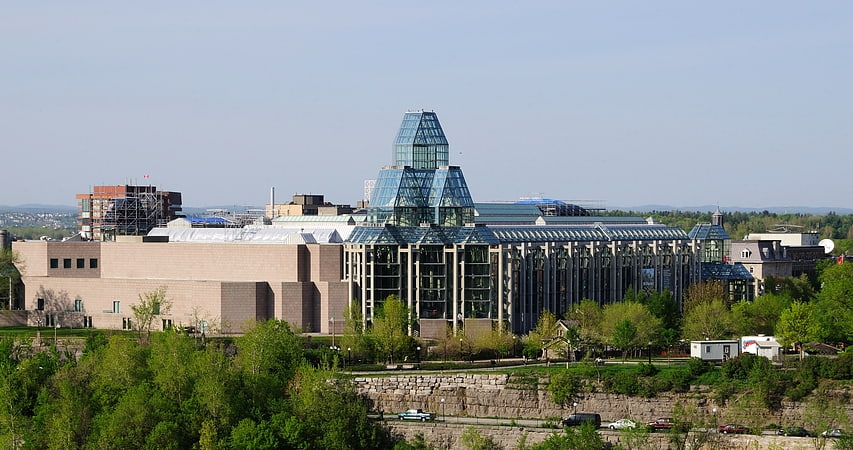
Art museum with many Canadian works. The National Gallery of Canada, located in the capital city of Ottawa, Ontario, is Canada's national art museum. The museum's building takes up 46,621 square metres, with 12,400 square metres of space used for exhibiting art. It is one of the largest art museums in North America by exhibition space.
The institution was established in 1880 at the Second Supreme Court of Canada building, and moved to the Victoria Memorial Museum building in 1911. In 1913, the Government of Canada passed the National Gallery Act, formally outlining the institution's mandate as a national art museum. The museum was moved to the Lorne building in 1960.
In 1988, the museum was relocated to a new building designed for this purpose. The National Gallery of Canada is situated in a glass and granite building on Sussex Drive, with a notable view of the Canadian Parliament buildings on Parliament Hill. The building was designed by Israeli architect Moshe Safdie and opened in 1988.
The museum's permanent collection includes over 93,000 works from European, American, and Asian, Canadian, and Indigenous artists. In addition to exhibiting works from its permanent collection, the museum also organizes and hosts a number of travelling exhibitions.[6]
Address: 380 Sussex Dr, K1N 9N4 Ottawa
Rideau Hall

Landmark house of the Governor General. Rideau Hall is the official residence in Ottawa of both the Canadian monarch and his or her representative, the governor general of Canada. It stands in Canada's capital on a 36-hectare estate at 1 Sussex Drive, with the main building consisting of approximately 175 rooms across 9,500 square metres, and 27 outbuildings around the grounds. Rideau Hall's site lies outside the centre of Ottawa. It is one of two official royal residences maintained by the federal Crown, the other being the Citadelle of Quebec.
Most of Rideau Hall is used for state affairs, only 500 square metres (5,400 sq ft) of its area being dedicated to private living quarters, while additional areas serve as the offices of the Canadian Heraldic Authority and the principal workplace of the governor general and his or her staff; either the term Rideau Hall, as a metonym, or the formal idiom Government House is employed to refer to this bureaucratic branch. Officially received at the palace are foreign heads of state, both incoming and outgoing ambassadors and high commissioners to Canada, and Canadian Crown ministers for audiences with either the viceroy or the sovereign, should the latter be in residence. Rideau Hall is likewise the location of many Canadian award presentations and investitures, where prime ministers and other members of the federal Cabinet are sworn in, and where federal writs of election are "dropped", among other ceremonial and constitutional functions.
Rideau Hall and the surrounding grounds were designated as a National Historic Site of Canada in 1977. The house is open to the public for guided tours throughout the year; approximately 200,000 visitors tour Rideau Hall annually. Since 1934, the Federal District Commission (now the National Capital Commission) has managed the grounds.[7]
Address: 1 Sussex Dr, K1A 0A1 Ottawa
Bytown Museum
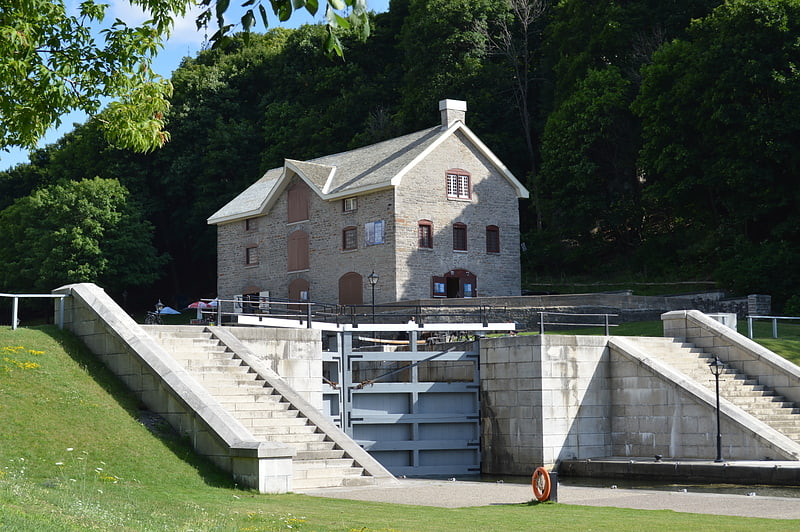
Museum in Ottawa, Ontario. The Bytown Museum is a museum in Ottawa located in the Colonel By Valley at the Ottawa Locks of the Rideau Canal at the Ottawa River, just below Parliament Hill. Housed in the Commissariat Building, Ottawa's oldest remaining stone building, the museum provides a comprehensive overview of the origins of Bytown and its development and growth into the present city of Ottawa.
Founded in 1917 by the Women's Canadian Historical Society of Ottawa (WCHSO), the Bytown Museum was originally located in the former City Registry Office at 70 Nicholas across from the Carleton County Gaol. The Museum moved to its current location in 1951 and has operated from the Commissariat since, with the exception of a brief period from 1982–1985, when Parks Canada, the building's landlord, conducted renovations.[8]
Address: 1 Canal Lane, K1P 5P6 Ottawa
Notre-Dame Cathedral Basilica
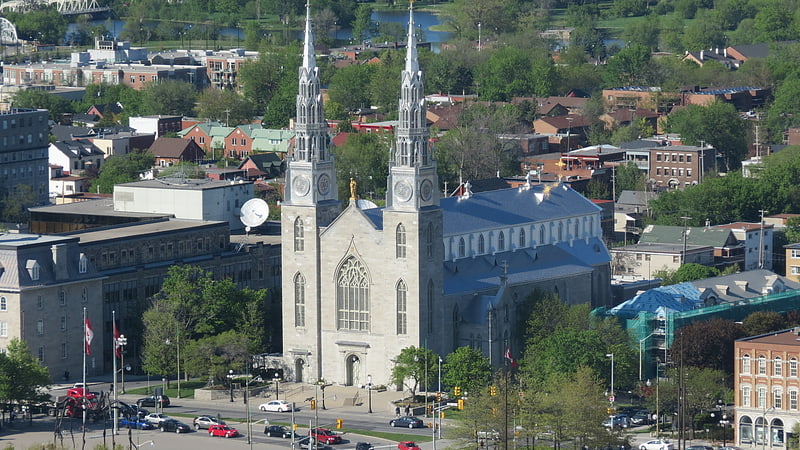
Towering, 19th-century church. The Notre-Dame Cathedral Basilica is a Roman Catholic minor basilica in Ottawa, Ontario, Canada located on 385 Sussex Drive in the Lower Town neighbourhood. It was designated a National Historic Site of Canada in 1990.
The Basilica is the oldest and largest church in Ottawa and the seat of the city's Roman Catholic archbishop. Its twin spires and gilded Madonna are easily identifiable from nearby Parliament Hill and the surrounding area. The church was last renovated and restored in the late 1990s. Services are held in both French and English. Its Easter and Christmas masses are telecast nationally on Salt+Light Television every year.[9]
Address: 56 Guigues Ave., K1N 5H5 Ottawa
Major's Hill Park
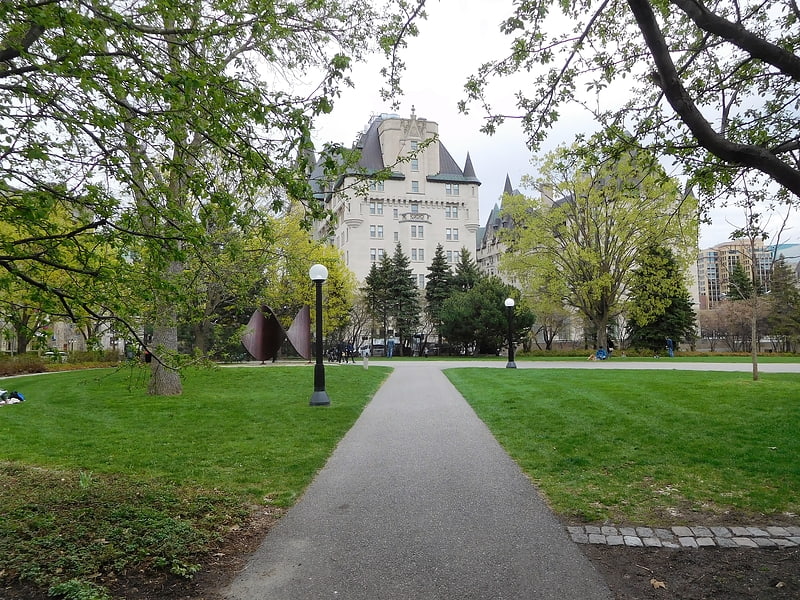
Park in Ottawa, Ontario. Major's Hill Park is a park in downtown Ottawa, Ontario. The park stands above the Rideau Canal at the point where it enters the Ottawa River. The parliament buildings can be seen across the canal to the west, to the north of the park is the National Gallery of Canada, and to the east are the United States embassy and the Byward Market. To the south is the Chateau Laurier hotel, built on land that was once part of the park.
The neighbourhood surrounding the park was once home to those who constructed the canal. In particular, the area that is now the park was the official residence of the Superintending Engineer of the Rideau Canal, Lieutenant-Colonel John By until he returned to England in 1832. The hill was known at the time as "Colonel's Hill". By was replaced in 1832 by Captain Daniel Bolton who took up residence in By's house. In 1838 Bolton was promoted to Major. By the time he left the Bytown in 1843, the hill had become known as Major's Hill. Commemorative plaques and a statue of Lieutenant-Colonel By, Major Bolton and their successors were erected in Major's Hill Park.
The residence was destroyed by fire on October 5, 1848, though ruins survive to today. The use of the area as a residence means that the park has remained a green space since the early days of Ottawa. It is now managed by the National Capital Commission, which has placed historical information in the northwest corner of the park.
Due to its central location, Major's Hill Park is frequented all year round. It is frequently used as a venue for events, and is central to Ottawa's civic Canada Day celebrations. A more recent addition to the calendar is the annual 'B In The Park', which precedes the Glengarry Highland Games. Pipe bands and highland dancers from all over the world perform. It is presented by the Sons of Scotland Pipe Band of Ottawa, which claims to be Canada's oldest continuous civilian pipe band.[10]
Address: 480-482 Mackenzie Ave, K1N 8S7 Ottawa
Canadian War Museum
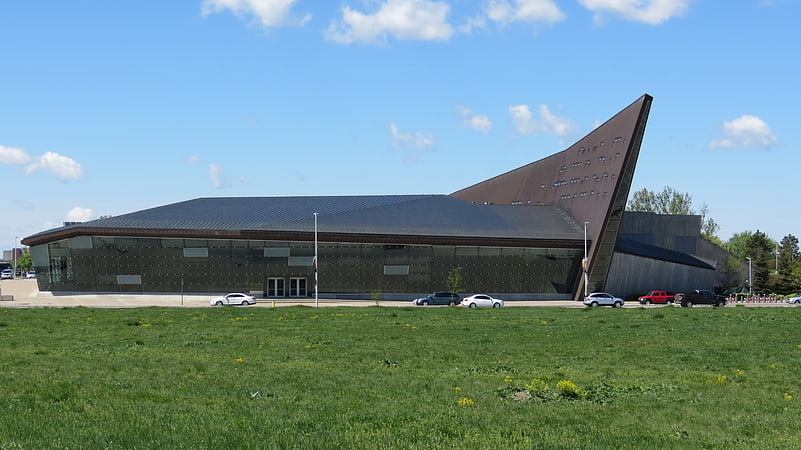
Exhibits on Canadian military history. The Canadian War Museum is a national museum on the country's military history in Ottawa, Ontario, Canada. The museum serves as both an educational facility on Canadian military history, in addition to serving as a place of remembrance. The 440,000 square metres museum building is situated south of the Ottawa River in LeBreton Flats. The museum houses a number of exhibitions and memorials, in addition to a cafeteria, theatre, curatorial and conservation spaces, as well as storage space. The building also houses the Military History Research Centre, the museum's library and archives.
The Canadian War Museum was formally established in 1942, although portions of the museum's collections originates from a military museum that operated from 1880 to 1896. The museum was operated by the Public Archives of Canada until 1967, when the National Museums of Canada Corporation was formed to manage several national institutions, including the war museum. In the same year, the war museum was relocated from its original building to the former Public Archives of Canada building. Management of the museum was later assumed by the Canadian Museum of Civilization Corporation (later renamed the Canadian Museum of History Corporation) in 1990. Plans to expand the museum during the mid-1990s resulted in the construction of a new building at LeBreton Flats. Designed by Moriyama & Teshima Architects and Griffiths Rankin Cook Architects, the new Canadian War Museum building was opened to the public in 2005.
The museum's collection contains over 500,000 pieces of materials related to military history, including over 13,000 pieces of military art. In addition to its permanent exhibition, the museum has hosted and organized a number of travelling exhibitions relating to Canadian military history.[11]
Address: 1 Vimy Pl, K1A 0M8 Ottawa
Canada Aviation and Space Museum

Educational exhibits and various aircraft. The Canada Aviation and Space Museum is Canada's national aviation history museum. The museum is located in Ottawa, Ontario, Canada, at the Ottawa/Rockcliffe Airport.[12]
Address: 11 Aviation Pkwy, K1K 4R3 Ottawa
National War Memorial

7-story arch honoring Canadian war vets. The National War Memorial, titled The Response, is a tall, granite memorial arch with accreted bronze sculptures in Ottawa, Ontario, Canada, designed by Vernon March and first dedicated by King George VI in 1939. Originally built to commemorate the Canadians who died in the First World War, it was in 1982 rededicated to also include those killed in the Second World War and Korean War and again in 2014 to add the dead from the Second Boer War and War in Afghanistan, as well as all Canadians killed in all conflicts past and future. It now serves as the pre-eminent war memorial of 76 cenotaphs in Canada. In 2000, the Tomb of the Unknown Soldier was added in front of the memorial and symbolizes the sacrifices made by all Canadians who have died or may yet die for their country.[13]
Address: 4 Elgin St, K1N 9N6 Ottawa
Chaudière Falls
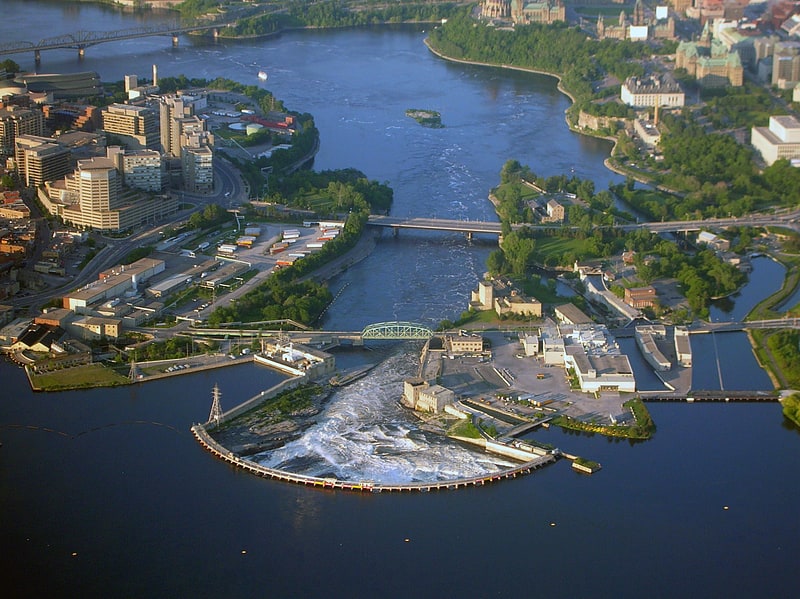
Waterfall in Ontario, Canada. The Chaudière Falls, also known as the Kana:tso or Akikodjiwan Falls, are a set of cascades and waterfall in the centre of the Ottawa-Gatineau metropolitan area in Canada where the Ottawa River narrows between a rocky escarpment on both sides of the river. The location is just west of the Chaudière Bridge and Booth-Eddy streets corridor, northwest of the Canadian War Museum at LeBreton Flats and adjacent to the historic industrial E. B. Eddy complex. The islands surrounding the Chaudière Falls, counter-clockwise, are Chaudière Island, Albert Island, little Coffin Island was just south of Albert Island but is now submerged, Victoria Island and Amelia Island, Philemon Island was originally called the Peninsular Village by the Wrights but became an island when the timber slide was built in 1829 it is now fused to south shore of City of Gatineau, and Russell Island, now submerged, was at the head of the Falls before the Ring dam was built. The falls are about 60 metres wide and drop 15 metres. The area around the falls was once heavily industrialized, especially in the 19th century, driving growth of the surrounding cities.
The damming of the river and the presence of industry have greatly altered the lands surrounding the waterfall, and the fall's appearance. This is especially true in the summer when the Ottawa River is low, and the falls all but disappear because the water is diverted to power stations owned and operated by Portage Power, an affiliate of Hydro Ottawa. Inaccessible for generations, the Falls and hydro facilities are now publicly accessible since the opening of Chaudiere Falls park in 2017, designed by architect Douglas Cardinal. Other properties adjacent to the Falls are slated for development by public and private interests, including an Indigenous welcome centre on Victoria Island, lead by the National Capital Commission (NCC) with regional First Nation representatives, and Zibi, a private mixed-use redevelopment project.[14]
Canadian Tomb of the Unknown Soldier

Historical landmark in Ottawa, Ontario. The Canadian Tomb of the Unknown Soldier is a tomb situated before the National War Memorial in Confederation Square, Ottawa, Ontario. The tomb is dedicated to Canadian service members, and holds the remains of an unidentified Canadian soldier who died in France during the First World War; selected from a Commonwealth War Grave near Vimy, in the vicinity where the Battle of Vimy Ridge took place.
A tomb with an unidentified soldier was added to the National War Memorial in 2000, the culmination of a project begun by the Royal Canadian Legion. Since 2007, the Canadian Armed Forces have posted sentries at the tomb, and the National War Memorial, from April to November.[15]
Address: 4 Elgin St., K1P 6K2 Ottawa
Capital Pathway
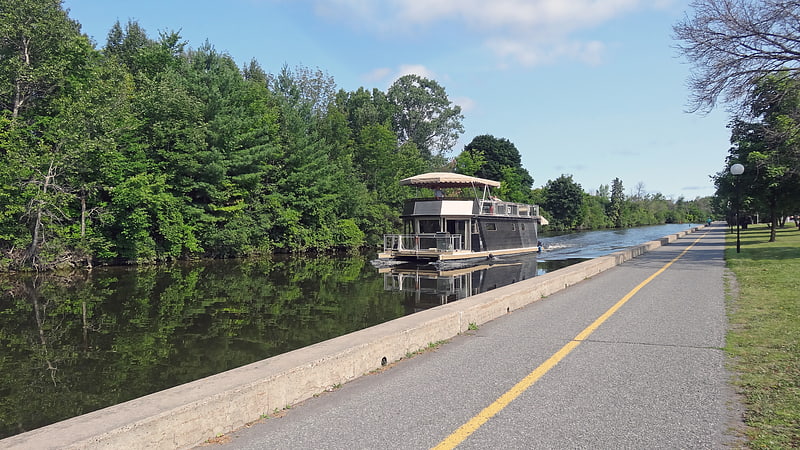
The Capital Pathway, also known informally as the Bike Path, is a 220-kilometre recreational pathway interlinking many parks, waterways and sites in Ottawa, Ontario and Gatineau, Quebec. Most of the pathway is paved, and allows an almost continuous route through the National Capital Region.
The pathway, was mostly the work of the National Capital Commission, a crown corporation created in 1959. The trail, which includes the Rideau Canal Pathway, the Ottawa River Pathway, and the Rideau River Pathway extends in all directions to the limits of the city of Ottawa and extends northward into Gatineau Park's lakes.[16]
Dow's Lake

Lake in Ontario, Canada. Dow's Lake in Ottawa, Ontario, Canada is a small man-made lake on the Rideau Canal, situated two kilometres north of Hog's Back Falls in the middle of Ottawa. It is at the south end of Preston Street, just south of Carling Avenue, and just to the west of Bronson Avenue. At the south end of the lake is Carleton University, and to the west is the Dominion Arboretum, at the edge of the Central Experimental Farm.[17]
Centennial Flame
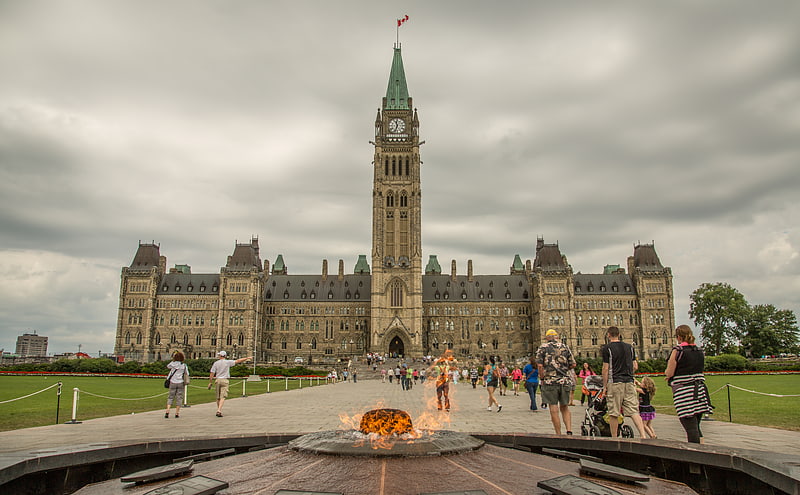
Monument to Canadian confederation. The Centennial Flame is a monument on Parliament Hill commemorating the 100th anniversary of the Canadian Confederation. First lit in January 1967, the Flame works with natural gas, presenting a fountain that does not freeze in winter. Any money thrown into it serves as a donation for people with disabilities, some of whom have received over $5,000.[18]
Address: Parliament Hill, Ottawa
Peace Tower
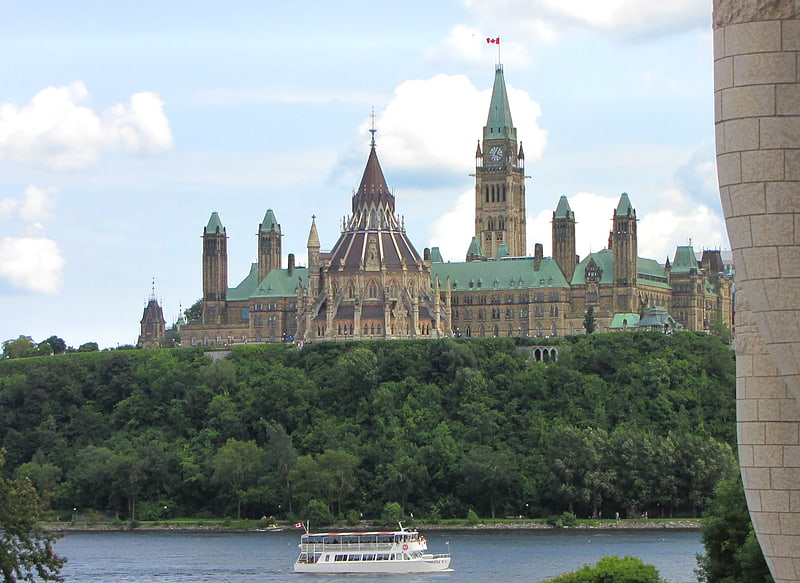
Tower in Ottawa, Ontario. The Peace Tower, also known as the Tower of Victory and Peace, is a focal bell and clock tower sitting on the central axis of the Centre Block of the Canadian parliament buildings in Ottawa, Ontario. The present incarnation replaced the 55-metre Victoria Tower after the latter burned down in 1916, along with most of the Centre Block; only the Library of Parliament survived. It serves as a Canadian icon and had been featured prominently on the Canadian twenty-dollar bill directly adjacent the queen's visage, until the change to polymer.[19]
Address: Parliament Hill, K1A 0A2 Ottawa
Confederation Park
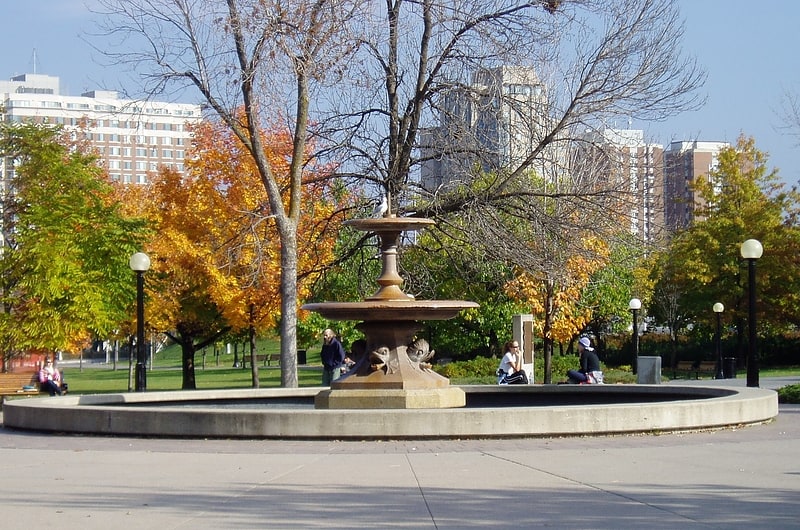
Park in Ottawa, Ontario. Confederation Park is a public park and National Historic Site of Canada, located in the downtown core of Ottawa, Ontario, Canada. It is bordered on the south by Laurier Avenue and Ottawa City Hall; on the east by the Rideau Canal and National Defence Headquarters; on the north by the Mackenzie King Bridge, the Rideau Centre and the National Arts Centre; and to the west by Elgin Street and the Lord Elgin Hotel.[20]
Address: Laurier Ave W, K1P 5J2 Kingston
Peacekeeping Monument
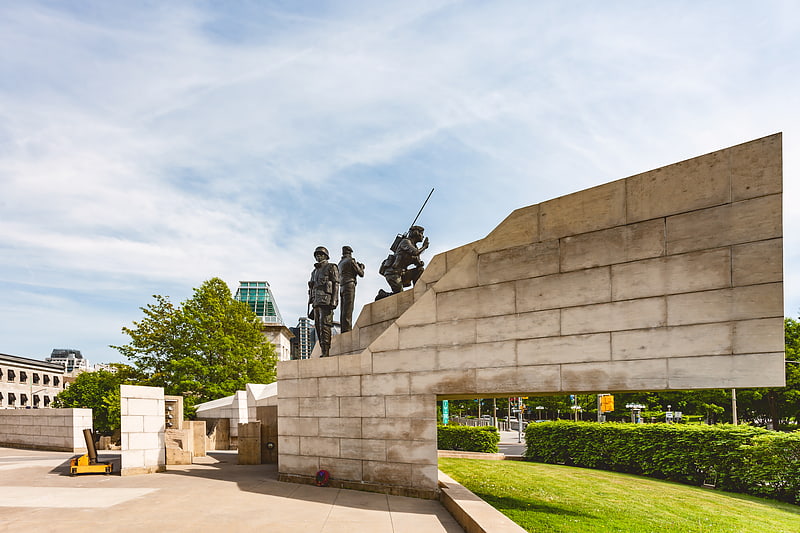
Art work. Reconciliation: The Peacekeeping Monument is a monument in Ottawa, the capital of Canada, commemorating Canada's role in international peacekeeping and the soldiers who have participated and are currently participating, both living and dead.
It is located between St. Patrick Street and Murray Street, in the centre of the intersection where they meet Mackenzie Avenue and Sussex Drive; this places it just south of the National Gallery of Canada and just north of the American Embassy and Major's Hill Park. Artist Jack Harman built the three soldiers with architects Richard and Gregory Henriquez designing the site concept and monument structures. Cornelia Oberlander was the landscape architect. The monument was completed in 1992.
The work, entitled Reconciliation, depicts three peacekeeping soldiers — two men and a woman — standing on two ridges of stone which cut through the broken debris of war and converge at a high point, which symbolizes the resolution which peacekeeping brings. The base of the monument includes Lester Pearson's 1956 quote "We need action not only to end the fighting but to make the peace.. My own government would be glad to recommend Canadian participation in such a United Nations force, a truly international peace and police force", as well as the French translation.
In 1995, the Monument was commemorated on the year's $1 coin, following the 1994 commemoration of the National War Memorial.[21]
Address: Off Murray Street, K1K 5A1 Ottawa
Rideau Carleton Raceway
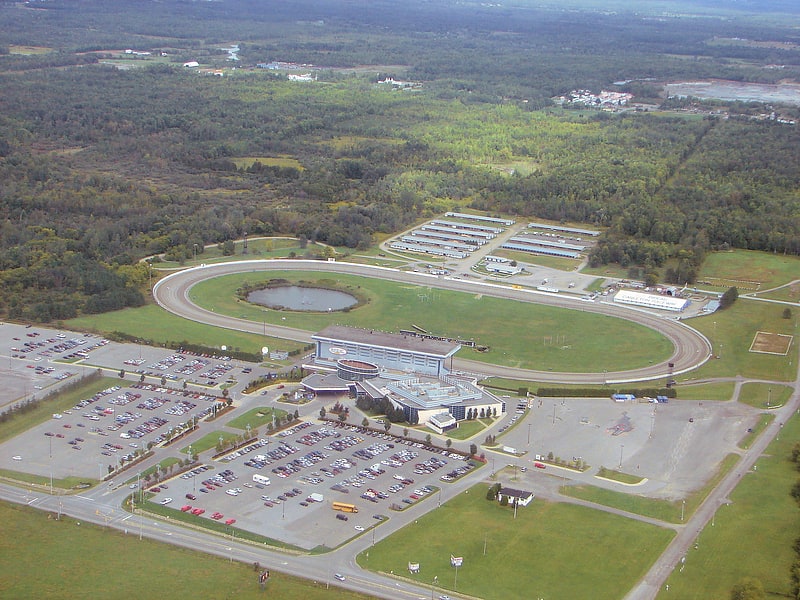
Sports facility in Ottawa, Ontario. Rideau Carleton Raceway is a Canadian horse racing and gambling complex located at 4837 Albion Road in Ottawa, Ontario. The facility began operation in 1962 and specialises in Standardbred harness racing.
In 2000, the venue introduced slot machines, under the authority of the Ontario Lottery and Gaming Corporation which were expected to draw annual revenue of $130 million. The site includes a restaurant and hosts musical performances.
Rideau Carleton is also the site of the Gloucester Fair since 1998. The raceway provides facilities for numerous charitable fundraisers and hosts annual events for several embassies.
The operations at the Raceway are currently run by Hard Rock Hotels and Casinos, which bought the facility in September 2017. Hard Rock holds 51% of the stock.[22]
Address: 4837 Albion Rd, South, K1X 1A3 Gloucester
Canadian Museum of Nature
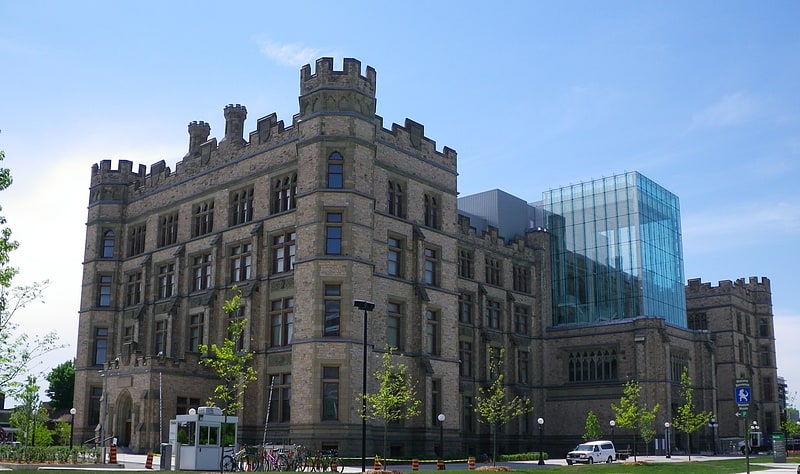
Collections exploring the natural world. The Canadian Museum of Nature is a national natural history museum based in Canada's National Capital Region. The museum's exhibitions and public programs are housed in the Victoria Memorial Museum Building, a 18,910 square metres structure in Ottawa, Ontario. The museum's administrative offices and scientific centres are housed at a separate location, the Natural Heritage Campus, in Gatineau, Quebec.
The museum originated from a museum established by the Geological Survey of Canada in 1856. Originally based in Montreal, the museum relocated to downtown Ottawa in 1881. In 1911, the museum relocated to Victoria Memorial Museum Building. Initially a natural history museum, the institution later expanded to include an anthropology and human history department; with the institution renamed the National Museum of Canada in 1927. The departments of the national museum were later split into separate national institutions, with the natural history department forming the National Museum of Natural Sciences in 1968. The museum adopted its current name in 1990, after it was made its own autonomous crown corporation. From 2004 to 2010 the museum renovated and expanded the Victoria Memorial Museum Building.
The museum's collection contains over 14.6 million specimens relating to the natural world, a number of which are displayed in the museum's permanent exhibitions. The museum also hosts and organizes a number of travelling exhibitions, as well as support and conducts a number of research programs relating to natural history.[23]
Address: 240 McLeod St, K1P 6P4 Ottawa
Nepean Point
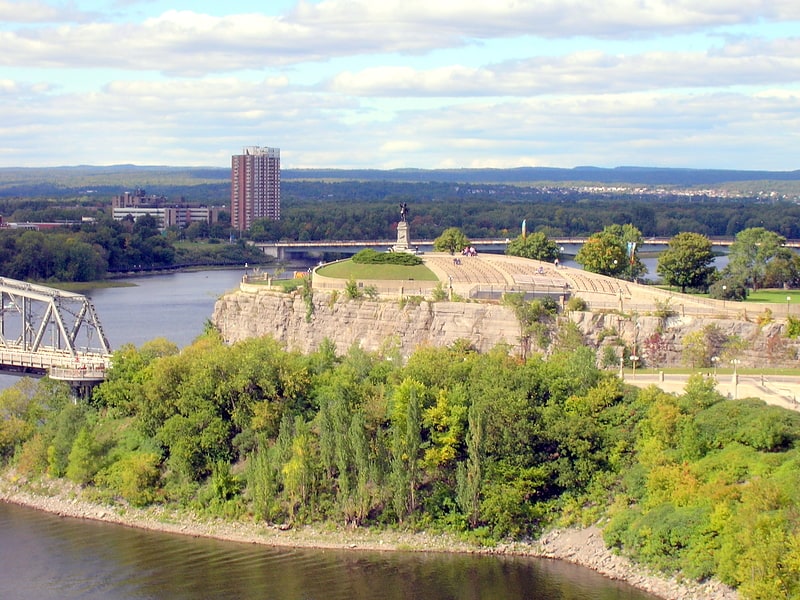
National park in Ottawa, Ontario. Nepean Point is a hill with scenic lookout in Ottawa, Ontario, Canada, overlooking the Ottawa River, Parliament, the Canadian Museum of History, and other features of downtown Ottawa and Gatineau. It is located between the National Gallery of Canada and Alexandra Bridge.
At the peak of the hill is a statue of French explorer Samuel de Champlain holding his famous astrolabe upside-down. It was made by sculptor Hamilton MacCarthy in 1915.
Previously, the statue also featured a kneeling First Nations scout, added in 1918 to "signify how the native people helped Champlain navigate through the waters of the Ottawa River", but this has been relocated to nearby Major's Hill Park.
The small amphitheatre on the point is known as "Astrolabe Theatre", presumably a reference to Champlain.[24]
Address: Alexandria Bridge, K1N 9N4 Ottawa
Watson's Mill
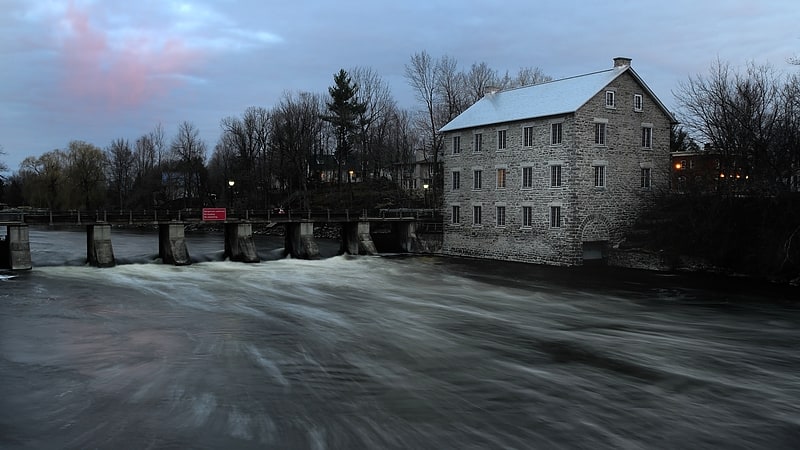
Museum in Ottawa, Ontario. Watson's Mill is an historic flour and gristmill in Manotick, Ontario, Canada. It is the only working museum in the Ottawa area and one of the very few operating industrial grist mills in North America. Watson's Mill still sells stone-ground whole wheat flour which is made on site. The mill is also well known for its ghost Annabelle. The legend is that Ann Currier, wife of Joseph, haunts the mill, following her death in a tragic accident there in 1861. Watson's Mill is Manotick's most recognized landmark. Its image is used as a symbol for the village.
Moss Kent Dickinson and Joseph Merrill Currier founded the mill as the Long Island Milling Enterprise in 1860. It was one of a series of mills constructed in the area using power from the Rideau Canal. It earned its current name when it was purchased by Harry Watson in 1946. Watson was the last owner to operate the mill at an industrial level. When the Rideau Valley Conservation Authority bought the mill in 1972, it was developed into a museum.
The mill is open to the public during the summer months and hosts a variety of events, including milling demonstrations every Sunday.[25]
Address: 5525 Dickinson St, K4M Manotick
National Arts Centre
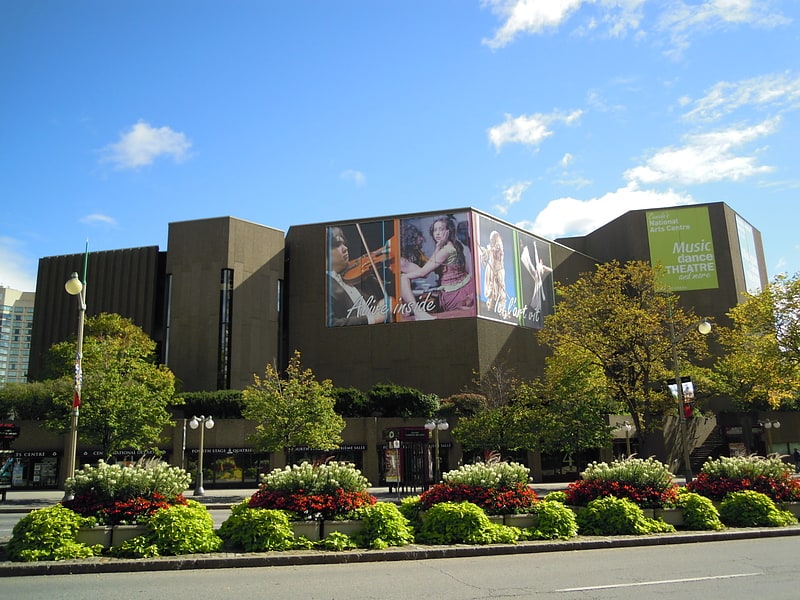
Building in Ottawa, Ontario. The National Arts Centre is a performing arts organisation in Ottawa, Ontario, along the Rideau Canal. It is based in the eponymous National Arts Centre building.[26]
Address: Ottawa, 1 Elgin Street
The Bank of Canada Museum
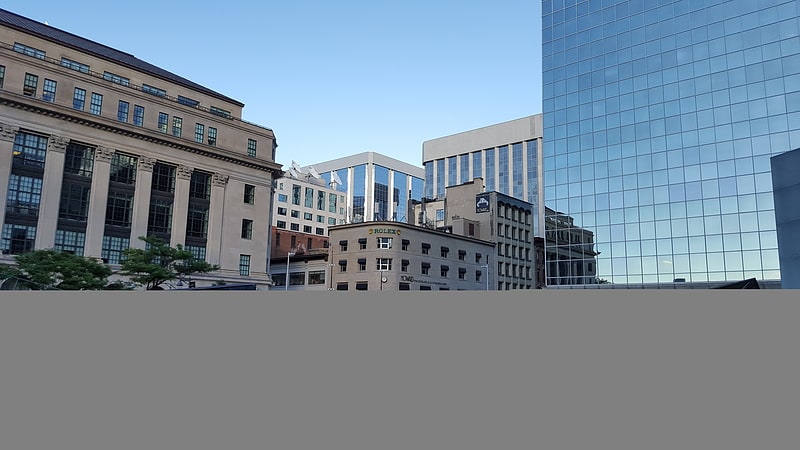
Museum in Ottawa, Ontario. The Bank of Canada Museum, formerly known as Canada's Currency Museum, opened in 1980 on the ground floor of the Bank of Canada building in Ottawa, Ontario, Canada. Temporarily closed in 2013 for major building renovations, the museum reopened in a new space on July 1, 2017, in a new building, with a completely new design and concept. It is, however, connected to the main building through the Bank of Canada's underground conference centre.
The museum used to be the public face of the National Currency Collection, which contains over 100,000 currency-related artifacts from around the world. These include coins, banknotes, dies, plates, and engraving tools, bank and government ledgers, weights and scales, cash registers, wallets, numismatic medals and cards and examples of counterfeit money. This collection was on display until 2013, and currently, most of it is in storage and is not available to visitors.
As of February 2021, the museum is working on replacing these artifacts, both by putting them out, and digitizing them.
The National Currency Collection also encompasses a library and archive, which contain over 8,500 books, pamphlets, catalogues and journals dating back to the Middle Ages.
The Museum offers various educational programs for school groups and the public, in both English and French.[27]
Address: 30 Bank Street, K1A 0G9 Ottawa
Ottawa Art Gallery
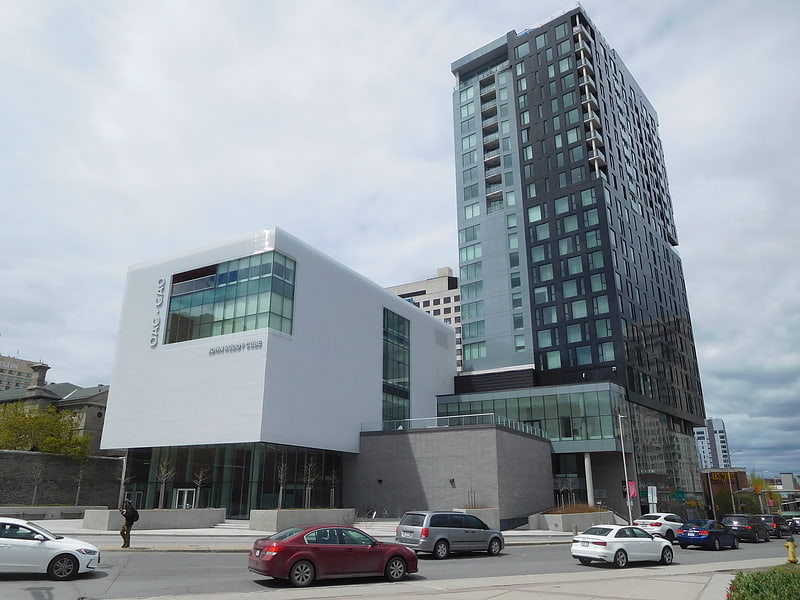
Art gallery in Ottawa, Ontario. The Ottawa Art Gallery is a municipal gallery in Ottawa, Ontario that opened in 1988 at Arts Court. The gallery has a permanent collection of over one-thousand works, houses the City of Ottawa-owned Firestone Collection of Canadian Art, and provides community, educational and public programming. The OAG focuses on acquiring, interpreting, and sharing art as well as acting as a cultural meeting place.[28]
Address: 2 Daly Avenue, Ottawa
Horaceville
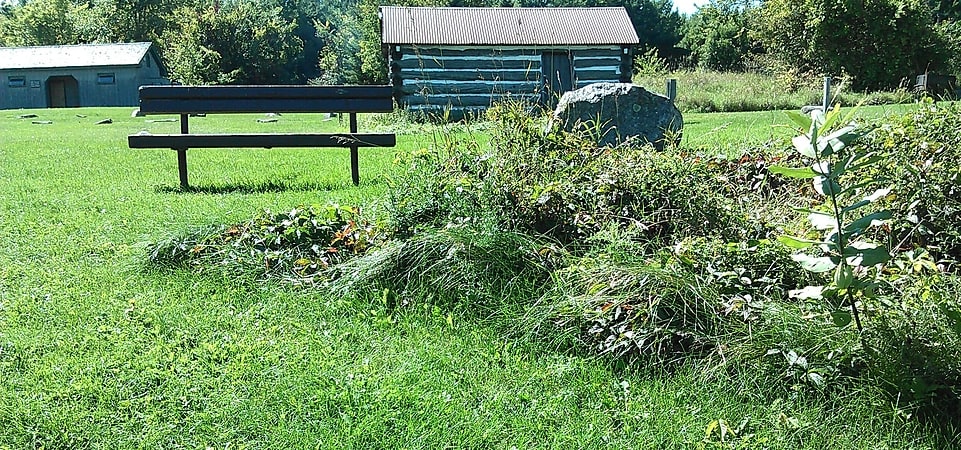
Museum in Ottawa, Ontario. Horaceville is a historic site located on the Ottawa River in eastern Ontario, Canada. The site remained the property of the heirs of Hamnett Kirkes Pinhey until the 1970s, when the property was sold to the township. Today, The 88-acre heritage site is owned and operated by the City of Ottawa and Pinhey's home serves as a museum. The museum is open May 14 through August 31, Wednesdays to Sundays, 11 am to 5 pm. This location is also known as Pinhey's Point Historic Site. The property was designated by the City of Ottawa under Part IV of the Ontario Heritage Act as having cultural heritage value or interest. A bronze plaque erected on the site by the Ontario Heritage Foundation describes the property's history: "Hamnet Kirkes Pinhey 1784 - 1857 - A merchant and ship owner in his native England, Pinhey came to Upper Canada in 1820. For his services as King's messenger during the Napoleonic Wars, he received a 1000 acres land grant on the Ottawa River. Within a decade he had built up an estate which he named Horaceville after his elder son. In addition to a manor house and barns, it included mills, a store and church. Pinhey took a leading part in township and district affairs. He was appointed to the Legislative Council in 1847, served as Warden of the Dalhousie District, and as the first Warden of Carleton County. Horaceville remained in family hands until 1959 when it was purchased by the National Capital Commission."
The site, which is a popular destination for boaters, cyclists, and picnics, consists of 88 acres (360,000 m2) of park land, a nearly 200-year-old stone manor house, two barns, scenic views of the River and several stone ruins. The manor house acts as a historic house museum with furnished rooms and temporary exhibits. The City of Ottawa offers multiple programs for families throughout its operating season (May - August) as well as some programs in the off-season. The park itself is open year-round. Admission to the museum is by donation; some of the programs and special events charge a small fee for participation. The venue can be rented for weddings, anniversaries, or any other special celebration.[29]
Andrew Haydon Park
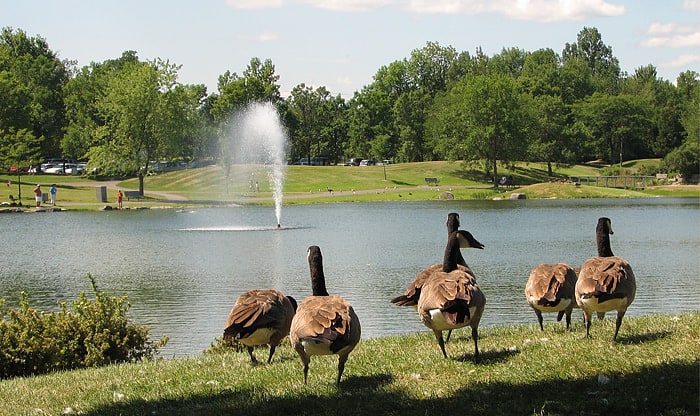
Park in Ottawa, Ontario. Andrew Haydon Park is a park on the Ottawa River that is managed by the City of Ottawa, Ontario, Canada. It is situated on Carling Avenue at Holly Acres Road.
There is a bandshell for outdoor concerts and a picnic area. The Nepean Sailing Club is located nearby at adjacent Dick Bell Park. The park features walking trails, play structures, and picnicking.
Migrating Canada geese, brants, ducks, and shorebirds stop over along the marshy edges of the river near the park. Resident Canada geese and mallards also inhabit the park's two ponds.
The park was named after Andrew Haydon, former Reeve of Nepean.
The landscape-architect Donald W. Graham worked on this project.[30]
Address: 3169 Carling Ave, Ottawa
War of 1812 Monument
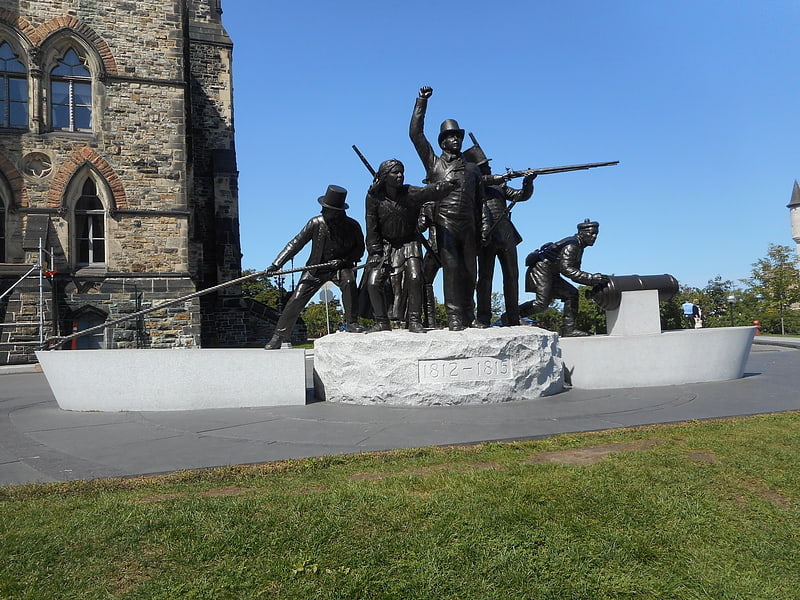
The War of 1812 Monument, officially titled Triumph Through Diversity, is a bronze and stone memorial, located at Parliament Hill in Ottawa, Ontario, Canada, Canada's capital. Seven figures—a First Nations fighter, a Métis militiaman, a regular infantryman from the Royal Newfoundland Regiment of Fencible Infantry, a Quebec soldier of the Canadian Voltigeurs being bandaged by a female figure, a Royal Navy marine, and a farmer—represent those who took part on the Canadian side of the War of 1812. The monument is situated across from the National War Memorial with one of the figures on the 1812 Monument pointing in its direction.
Also part of the monument is a maple tree planted in soil taken from 10 Canadian battlefield sites and watered at the dedication with water from six oceans and lakes significant in the War of 1812. The tree symbolizes the Canadian nation that grew out of the effort to defend Canada during the War of 1812.
The monument was dedicated on 6 November 2014, the 200th anniversary of the war's final battle in Canada, the Battle of Malcolm's Mills.[31]
Dominion Arboretum

Arboretum in Ottawa, Ontario. The Dominion Arboretum is an arboretum part of the Central Experimental Farm of Agriculture and Agri-Food Canada in Ottawa, Ontario, Canada. Originally begun in 1889, the Arboretum covers about 26 hectares of rolling land between Prince of Wales Drive, Dow's Lake and the Rideau Canal. Carleton University is located at the opposite side of the Canal. At a latitude of 45°, it can experience extremely hot and humid summers and extremely cold winters.
It displays a wide range of well-established trees and shrubs with the intention of evaluating their hardiness, including 1,700 different species and varieties. The arboretum is open from dawn to dusk and the admission is free.
Although the climate of the Ottawa area is Zone 5a, the topography of the Arboretum produces a microclimate and is warmer by one zone. This has allowed for a collection of magnolias, azaleas, and several other fringe trees including Metasequoia and Liriodendron.
One of the favourite attractions for tourists is the Ornamental Gardens. In this area are located the annual plant display, perennial borders, lilac walks, roses and hedges. The hedge collection was planted between 1966 and 1968 and contains a variety of species suitable for use as a hedge.[32]
Address: Prince of Wales Dr, Ottawa
St Patrick's Basilica
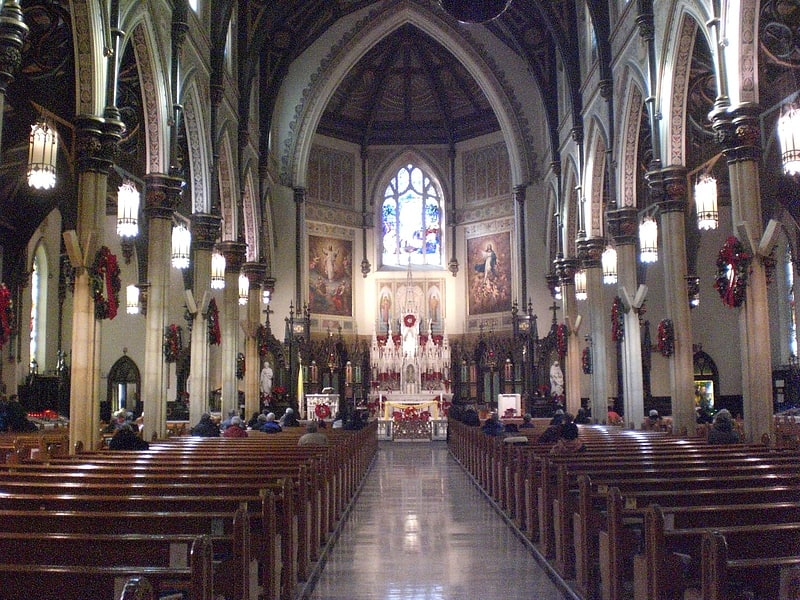
Catholic church in Ottawa, Ontario. St Patrick's Basilica is a Roman Catholic Church in Ottawa, Ontario, Canada. Located at 281 Nepean Street in Downtown Ottawa, it is the oldest church in the city that serves the English-speaking community. The Basilica is one of the regular buildings featured in the Doors Open Ottawa architectural heritage day.[33]
Address: 281 Nepean St, K1R 5G2 Ottawa
Commissioners Park
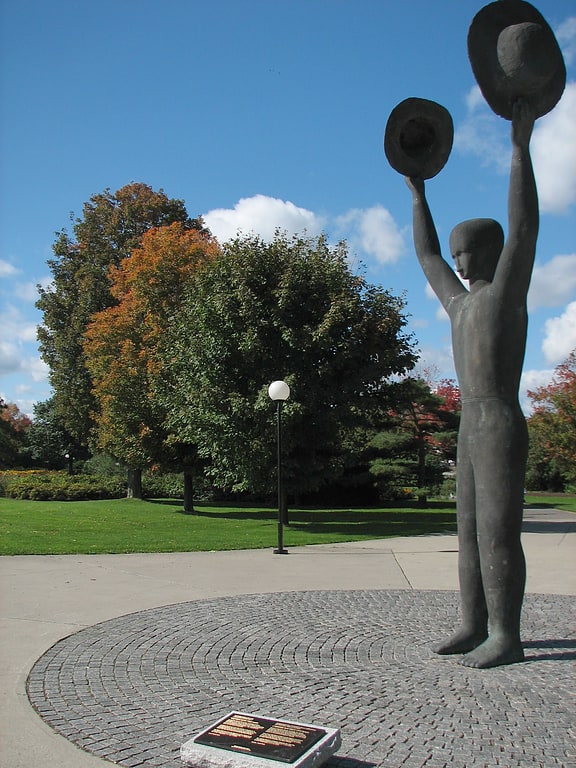
Park in Ottawa, Ontario. Commissioners Park is a park in Ottawa, Ontario, Canada. It lies within the westernmost section of The Glebe, bounded by Dow's Lake, Preston Street, Carling Avenue and Dow's Lake Road.
Throughout the warmer months it is a popular place for family walks. The National Capital Commission maintains the park and manages to keep flowers blooming there throughout the growing season. During the annual Canadian Tulip Festival, it is a major tulip viewing area with the highest concentration of tulips in the region numbering as many as 300,000.[34]
Lord Stanley's Gift Monument
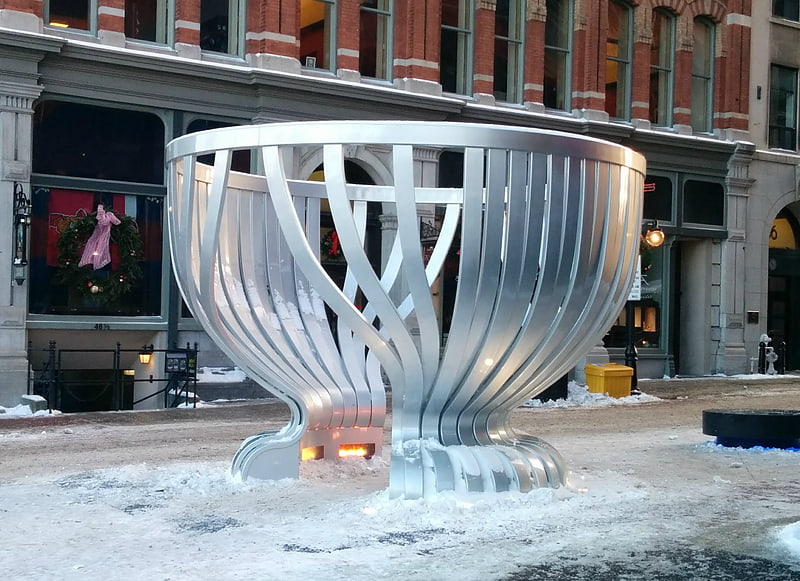
Historical landmark in Ottawa, Ontario. The Lord Stanley's Gift Monument is a monument in Ottawa, Ontario, Canada. It commemorates the donation of the Stanley Cup ice hockey championship trophy by Canada's Governor-General the Lord Stanley of Preston in 1893. It is located on the eastern end of the Sparks Street Mall. It was constructed at the culmination of a public campaign to commemorate the donation of the trophy.[35]